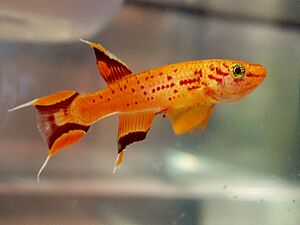Lyretail panchax facts for kids
Quick facts for kids Lyretail panchax |
|
|---|---|
 |
|
| Golden variety of Aphyosemion australe Male | |
| Conservation status | |
| Scientific classification | |
| Synonyms | |
|
The lyretail panchax, also known as the golden panchax or Cape Lopez lyretail, is a type of small freshwater fish. Its scientific name is Aphyosemion australe. This fish belongs to the Aplocheilidae family. You can find these colorful fish swimming in the waters around Cape Lopez and nearby areas in the country of Gabon, located in Africa.
What Does It Look Like?
A. australe fish come in two main color types. The natural, wild fish are brown and are often called 'chocolate' by fish keepers. There is also a beautiful orange 'gold' form. This golden color appeared as a natural change, or mutation, and was then bred by a fish hobbyist from Finland in 1952.
Males of this species can grow to about 6 centimeters (about 2.4 inches) long. Females are usually a little smaller. The male fish have a special tail fin that looks like a lyre, which is a type of harp. This lyre-shaped tail is a common feature for fish in this group. Females are not as brightly colored as males. Their bodies are brownish-tan if they are the wild type, or a light tan if they are the gold/orange type. Their fins are also more rounded than the males'. In the aquarium world, you might also see darker 'chocolate' types or even 'spotless' versions.
Keeping Them as Pets
The Cape Lopez lyretail is a very popular fish for home aquariums. It is one of the most common types of killifish that people keep. These fish are quite easy to care for and will often lay eggs in a home tank.
Reproduction and Life Cycle
They like to lay their eggs among fine-leafed water plants, like aquatic moss. After about 14 days, tiny baby fish, called fry, will hatch from the eggs. This usually happens when the water temperature is around 26 degrees Celsius (about 79 degrees Fahrenheit).
What Do They Eat?
These fish are not picky eaters. They can eat many kinds of fish food you buy at the store, such as flakes or frozen foods. However, like most killifish, they are healthiest and happiest when they get to eat live foods. These can be tiny insects or worms that are grown or caught from clean places.


